The Superficial Radiation Therapy System Market is estimated to be valued at USD 48.4 billion in 2025 and is projected to reach USD 70.3 billion by 2035, registering a compound annual growth rate (CAGR) of 3.8% over the forecast period.
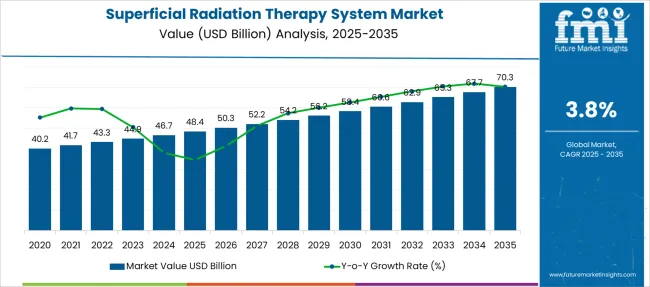
| Metric | Value |
|---|---|
| Superficial Radiation Therapy System Market Estimated Value in (2025 E) | USD 48.4 billion |
| Superficial Radiation Therapy System Market Forecast Value in (2035 F) | USD 70.3 billion |
| Forecast CAGR (2025 to 2035) | 3.8% |
The superficial radiation therapy system market is witnessing consistent advancement, fueled by increasing incidence of non-melanoma skin cancers and the rising demand for non-invasive treatment modalities. Growing awareness of skin cancer treatment options, coupled with early-stage detection supported by dermatology outreach, is increasing the adoption of precise, superficial radiotherapy systems.
These systems offer targeted treatment with minimal impact on surrounding healthy tissues, making them particularly suitable for cosmetic-sensitive areas. Advancements in dose control, patient immobilization, and integrated imaging are enhancing treatment accuracy and outcomes.
In addition, reimbursement support across several regions and the growing preference for outpatient radiation solutions are accelerating the shift away from surgical excisions. The market outlook remains strong, with adoption expected to deepen across community hospitals and dermatology clinics as technology becomes more compact, cost-effective, and integrated into multidisciplinary care settings.
The market is segmented by Product Type, Application, and End User and region. By Product Type, the market is divided into Superficial Radiation Therapy Systems and Software. In terms of Application, the market is classified into Basal Cell Carcinoma, Squamous Cell Carcinoma, Keloid scars, Psoriasis, Kaposi Sarcoma (Plaque Stage), Bowen’s Disease, Cutaneous T-cell Lymphoma, and Soft Tissue Metastases. Based on End User, the market is segmented into Hospitals, Ambulatory Surgical Centers, Cancer Research Institutes, and Dermatology Centers. Regionally, the market is classified into North America, Latin America, Western Europe, Eastern Europe, Balkan & Baltic Countries, Russia & Belarus, Central Asia, East Asia, South Asia & Pacific, and the Middle East & Africa.
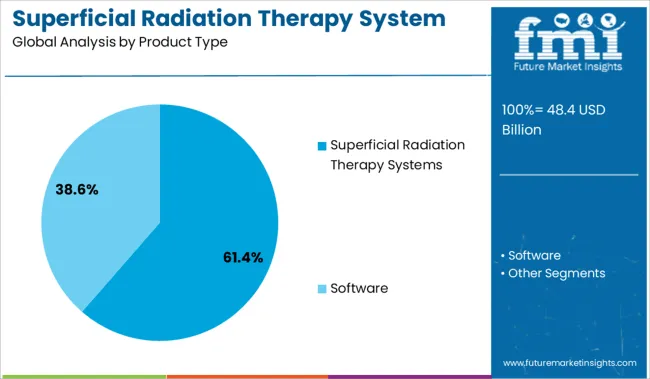
Superficial radiation therapy systems are projected to contribute 61.40% of total market revenue in 2025, positioning this product type as the leading segment. Their dominance is being reinforced by clinical preference for surface-level, non-invasive radiotherapy in treating early-stage non-melanoma skin cancers.
These systems enable localized treatment with minimal systemic toxicity, leading to faster patient recovery and fewer complications. The compact design and ease of installation in outpatient and ambulatory settings have also contributed to broader accessibility, particularly in dermatology-focused practices.
Technological upgrades such as electronic brachytherapy compatibility, automated dosimetry, and advanced beam-shaping capabilities have strengthened therapeutic outcomes. Regulatory approvals and inclusion in reimbursement frameworks have further driven institutional investments in this equipment category, solidifying its market leadership.
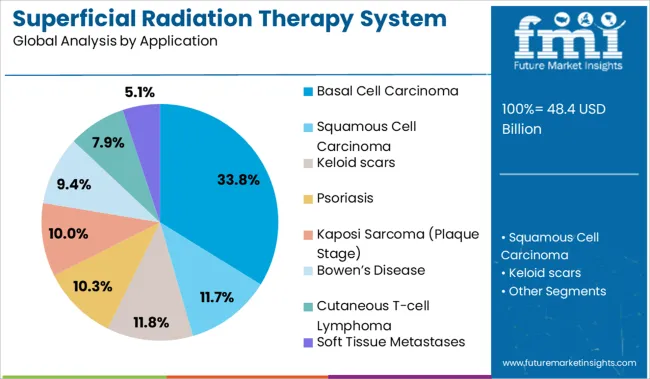
Basal cell carcinoma is expected to account for 33.80% of the application share in 2025, emerging as the largest treated indication in the superficial radiation therapy system market. This segment’s leadership is attributed to the high global prevalence of basal cell carcinoma, particularly among aging populations and individuals with prolonged UV exposure.
Radiation therapy has increasingly been adopted as a primary or adjunctive treatment in cases where surgical resection may compromise aesthetic outcomes or involve complex anatomical locations. Enhanced imaging and contouring tools now allow for precision-targeted treatment, minimizing recurrence risks.
With dermatologists and radiation oncologists emphasizing organ preservation and patient quality of life, superficial radiation therapy has become an accepted standard in basal cell carcinoma care protocols. Continued screening programs and increasing dermatology consultations are expected to sustain demand within this application.
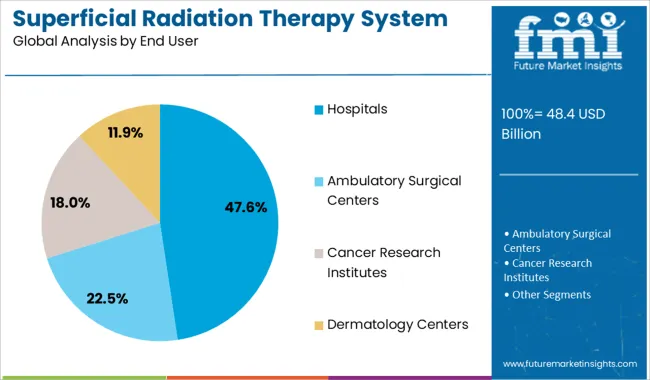
Hospitals are projected to represent 47.60% of the total market share by 2025, making them the leading end-user segment for superficial radiation therapy systems. This dominance is being driven by hospitals’ capacity to integrate radiation therapy systems into comprehensive oncology departments, ensuring a multidisciplinary approach to cancer treatment.
Access to capital budgets, qualified radiation oncologists, and in-house diagnostic imaging allows hospitals to offer end-to-end care, making them a preferred setting for patients. Additionally, the demand for outpatient radiotherapy procedures has grown within hospital-operated ambulatory wings, enabling hospitals to treat a broader range of dermatologic cancers without surgical intervention.
Accreditation requirements and safety protocols are also more readily fulfilled in hospital settings, supporting continued equipment upgrades. As hospitals increasingly expand their dermatologic oncology services, their leadership in system procurement and usage is expected to persist.
| Particulars | Details |
|---|---|
| H1 - 2024 | 3.80% |
| H1 – 2025 Projected | 3.77% |
| H1 – 2025 Outlook | 3.67% |
| BPS Change - H1, 2025 (O) – H1, 2025 (P) | (-) 10 ↓ |
| BPS Change– H1, 2025 (O) – H1, 2024 | (-) 13 ↓ |
According to Future Market Insights Analysis, the global superficial radiation therapy system market will see an approximately 13-unit decrease in Basis Point Share (BPS) from H1- 2024 to H1- 2025(O). H1-2025 outlook period in comparison to H1-2025 projected period showed a negative growth in terms of Basis Point Share by 10 BPS.
This was mostly due to the impact of cost factors related with robotic superficial radiation therapy systems, which resulted in greater development costs and lower adoption rates. This is based on value consumption as stated by the key competitors.
However, various key factors such as the implementation of surface guided radiation technique (SGRT), which improves patient isocentric and postural alignment accuracy and reproducibility, as well as efficiency and safety in cancer radiotherapy shows a promising growth for this market in near future.
Furthermore, because radiation levels off at the peripheral, the aspect of unequal dosage administration would hinder the growth of the superficial radiation therapy system market.
Sales of superficial radiation therapy system grew at a CAGR of 3.5% between 2014 and 2024.
Increasing adoption of SRT treatment in various end-user, ozone layer depletion and extensive results of radiotherapy for the cancer treatment are major drivers for superficial radiation therapy system market.
The use of superficial radiations therapy for cancer treatment is increasing due to their non-invasive nature, which penetrates up to 5 millimeter of the skin surface. The use of chemotherapy alone is not as effective as the chemo-radiotherapy in cancer patients, which is one of the reasons why radiotherapy is mostly adopted.
As per the AAC Journal, out of 40.2 Million cancer survivors in 2020, around 46.7 Million received radiotherapy treatment and this number was expected to increase up to 3.38 Million by 2024
Moreover, the device offers minimally invasive procedure which has reduced the chances of pain and scar in the body. The positive result outcomes by the use of the superficial radiation therapy system on the non-melanoma skin cancer patients have led to the high adoption of the system in various end-user such as cancer institutes and dermatology clinics.
Considering this, FMI expects the global superficial radiation therapy system market to grow at a CAGR of 3.8% through 2035.
Side effects associated with radiation therapy and large number of unaware population are the key factors restraining the market growth over the forecast period. Patient treated with SRT system are likely to face side effects such as dryness, hair loss, itching, redness and sometimes can face severe symptoms.
Also, there is a huge chance of reoccurrence of non-melanoma skin cancer and keloid scar as the SRT treatment does not assure complete cure of the disease. This factor is likely to affect the market growth of the superficial radiation therapy system.
In addition, According to the Skin Cancer Foundation survey, the majority of the general and affected population are unaware of a potential and widespread impact of life-threatening skin cancer.
According to the survey conducted by The Harris Poll in collaboration with Sanofi and Regeneron, it was stated that approximately 74% of the American population are unaware of being suffering from cutaneous squamous cell carcinoma, which is the 2nd most common skin cancer in the USA
These are some of the factors which may restraint the growth of the market in the forecast period.
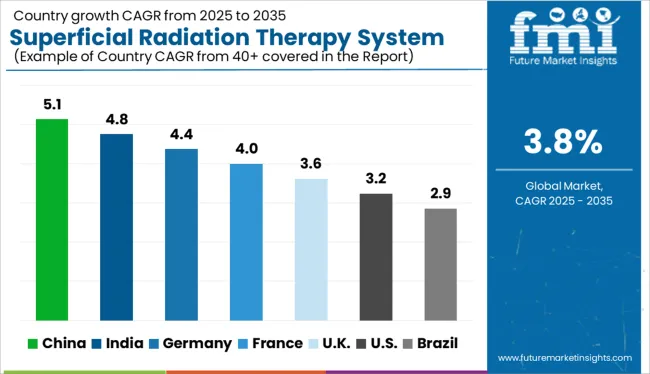

The USA is estimated to account for around 88.9% of the North America superficial radiation therapy system market in 2025.
The dominant share of USA can mainly be owing to the rapidly increasing incidence of skin cancer, rising geriatric population and various education programmes. Around 90% of non-melanoma skin cancer occurs due to exposure to UV sun lights. Newly diagnosed cases of skin cancer are rapidly increasing in the USA
Although the incidence of skin cancer is increasing rapidly, the death rate has decreased from 1991 to 2020. The decrease in death rate is majorly due to rising early diagnosis, and availability of advanced treatment options. In the USA, the diagnosis and treatment for non-melanoma skin cancers have raised by 77% between 1994 and 2014 in the USA
Additionally, with the increased burden of skin cancer, many campaigns and initiatives have been carried out to raise awareness amongst the population regarding the consequences of the skin disease caused due to excessive exposure to the sun. May month is considered to be the month of skin cancer awareness. Many skin cancer survivals are encouraged to share their stories on the social media platform to raise awareness.

Germany is estimated to account for 26.3% of the Europe superficial radiation therapy system market in 2025.
Germany is expected to lead the market owing to technological advancements and introduction of portable machines in end user. There has constant development of superficial radiation therapy technology which is widely used to treat non-melanoma skin cancer. The superficial radiation therapy system has become easily available in end-user segment settings through which radiation therapy has been performed with positive and effective outcomes.
With the introduction of portable superficial radiation therapy systems, the appropriate employment of dermatology practices in an office-based setting has increased from the past few years. Technological advancements of portability features are likely to further boost growth of the HCMS market in the near future.
The superficial radiation therapy system market in China is estimated to be worth USD 48.4 Million in 2025 in the global market.
In developing countries like China, many education courses which is required to perform effective radiation therapy are being provided for positives outcomes. The education courses mainly focuses on well-versed healthcare professionals with delivery and planning of advanced radiation therapy for the treatment of cancer.
It is an important way to increase the pool of qualified professionals and maximize the use of this radiation technology to fight against cancer. This can navigate the rising cases of cancer in china and drive the market.
The superficial radiation therapy system market in India is anticipated to be capture around 76.3% of the global market share in 2025. The global issues like ozone layer depletion has increased the amount of ultraviolet light that reaches the earth surface which has led to the rise in many skin related disorder, even in countries like India, where its impact can clearly be seen.
The general population is not much aware of the risk factors associated with insufficient and inflated sunlight exposure. However, many players are now entering into this market to serve the large patient pool suffering from cancer or related disease requiring such radiation treatment.
These factors are expected to increase the patient pool with the skin-related disorder and likewise demand for treatment procedures and is likely to propel the growth of the market.
By product type, superficial radiation therapy systems is anticipated to hold the maximum share of 95.8% in 2025, expanding at rate of nearly 3.9% during the forecast period.
The SRT system software provides complete patients details and provides products for various phases and stages of pre-planning, treatment, management and manipulation of the radiation therapy treatment procedure till follow-up. This advantage of this type of unique software solution allow physicians to use the patient data in the most effective and efficient ways.
The software helps in the treatment planning, verification and information management, collects treatment data and images. Due to their growing popularity and demand, this segment takes the highest share.
By application, Basal Cell Carcinoma will lead the market and is projected to account for 42.9% of the total market revenue share in 2025.
Basal cell carcinoma is the most common type of skin cancer, which grows in the skin area damaged by sunrays. The growth of this type of cancer is very slow and is unlikely to spread from the skin to other parts of the body, but it can move to nearby bone or other tissues under the skin. Cancer majorly affect basal cell of skin. Thereby, driving the demand for this segment.
By End User, hospital segment is anticipated to hold the maximum share of 35.5% in 2025, expanding at rapid rate of 3.9% CAGR during the forecast period.
Superficial radiation therapy system is easily installed in hospitals and cost of installation return can easily be received from patient’s bill. Moreover, walk in patient in hospital for radiation therapy is more compared to any other healthcare setup. These are some of the major factors expected to boom the demand for hospitals.
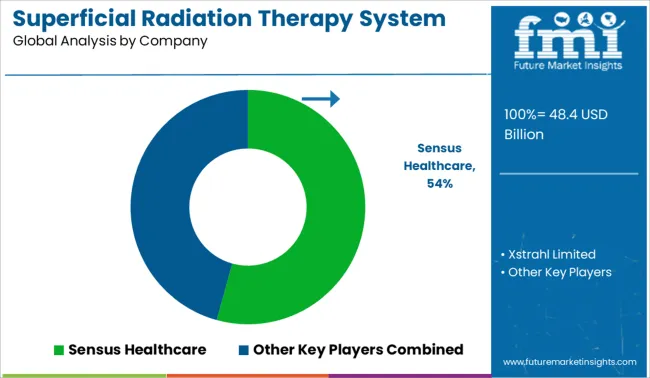
Companies operating in the superficial radiation therapy system market are fragmented by nature, with a presence of few players. These players are involved in a number of strategic alliances. The agreement and system automation accelerates the manufacturer’s strategy to capitalize on the market share and capture the significant share of market.
Some of the recent instances include:
| Attribute | Details |
|---|---|
| Forecast Period | 2014 to 2024 |
| Historical Data Available for | 2025 to 2035 |
| Market Analysis | USD Billion for Value |
| Key Countries Covered | USA, Canada, Brazil, Mexico, Argentina, Germany, UK, France, Italy, Spain, BENELUX, Russia, Nordic, China, Japan, South Korea, India, Indonesia, Malaysia, Thailand, Australia, New Zealand, GCC Countries, South Africa, Turkey |
| Key Segments Covered | Product Type, Application, End User and Region |
| Key Companies Profiled | Sensus Healthcare; Xstrahl Limited |
| Report Coverage | Market Forecast, Competition Intelligence, DROT Analysis, Market Dynamics and Challenges, Strategic Growth Initiatives |
| Customization & Pricing | Available upon Request |
The global superficial radiation therapy system market is estimated to be valued at USD 48.4 billion in 2025.
The market size for the superficial radiation therapy system market is projected to reach USD 70.3 billion by 2035.
The superficial radiation therapy system market is expected to grow at a 3.8% CAGR between 2025 and 2035.
The key product types in superficial radiation therapy system market are superficial radiation therapy systems and software.
In terms of application, basal cell carcinoma segment to command 33.8% share in the superficial radiation therapy system market in 2025.






Our Research Products

The "Full Research Suite" delivers actionable market intel, deep dives on markets or technologies, so clients act faster, cut risk, and unlock growth.

The Leaderboard benchmarks and ranks top vendors, classifying them as Established Leaders, Leading Challengers, or Disruptors & Challengers.

Locates where complements amplify value and substitutes erode it, forecasting net impact by horizon

We deliver granular, decision-grade intel: market sizing, 5-year forecasts, pricing, adoption, usage, revenue, and operational KPIs—plus competitor tracking, regulation, and value chains—across 60 countries broadly.

Spot the shifts before they hit your P&L. We track inflection points, adoption curves, pricing moves, and ecosystem plays to show where demand is heading, why it is changing, and what to do next across high-growth markets and disruptive tech

Real-time reads of user behavior. We track shifting priorities, perceptions of today’s and next-gen services, and provider experience, then pace how fast tech moves from trial to adoption, blending buyer, consumer, and channel inputs with social signals (#WhySwitch, #UX).

Partner with our analyst team to build a custom report designed around your business priorities. From analysing market trends to assessing competitors or crafting bespoke datasets, we tailor insights to your needs.
Supplier Intelligence
Discovery & Profiling
Capacity & Footprint
Performance & Risk
Compliance & Governance
Commercial Readiness
Who Supplies Whom
Scorecards & Shortlists
Playbooks & Docs
Category Intelligence
Definition & Scope
Demand & Use Cases
Cost Drivers
Market Structure
Supply Chain Map
Trade & Policy
Operating Norms
Deliverables
Buyer Intelligence
Account Basics
Spend & Scope
Procurement Model
Vendor Requirements
Terms & Policies
Entry Strategy
Pain Points & Triggers
Outputs
Pricing Analysis
Benchmarks
Trends
Should-Cost
Indexation
Landed Cost
Commercial Terms
Deliverables
Brand Analysis
Positioning & Value Prop
Share & Presence
Customer Evidence
Go-to-Market
Digital & Reputation
Compliance & Trust
KPIs & Gaps
Outputs
Full Research Suite comprises of:
Market outlook & trends analysis
Interviews & case studies
Strategic recommendations
Vendor profiles & capabilities analysis
5-year forecasts
8 regions and 60+ country-level data splits
Market segment data splits
12 months of continuous data updates
DELIVERED AS:
PDF EXCEL ONLINE
Superficial Punctate Keratitis Treatment Market Insights – Demand and Growth Forecast 2025 to 2035
Radiation Tolerant LED Light Market Size and Share Forecast Outlook 2025 to 2035
Radiation Hardened Electronics Market Size and Share Forecast Outlook 2025 to 2035
Radiation Protection Cabins Market Size and Share Forecast Outlook 2025 to 2035
Radiation-Free Fetal Heart Rate Monitor Market Size and Share Forecast Outlook 2025 to 2035
Radiation Hardened Microcontrollers Market Size and Share Forecast Outlook 2025 to 2035
Radiation Detection Device Market Size and Share Forecast Outlook 2025 to 2035
Radiation Curable Coatings Market Size and Share Forecast Outlook 2025 to 2035
Radiation Toxicity Treatment Market Size and Share Forecast Outlook 2025 to 2035
Radiation-Induced Myelosuppression Treatment Market Size and Share Forecast Outlook 2025 to 2035
Radiation Dose Optimisation Software Market Size and Share Forecast Outlook 2025 to 2035
Radiation Tester Market Growth – Trends & Forecast 2025 to 2035
Radiation-Induced Fibrosis Treatment Market - Growth & Forecast 2025 to 2035
Radiation Proctitis Treatment Market
Radiation Therapy Software Market Size and Share Forecast Outlook 2025 to 2035
Irradiation Apparatus Market Trends – Growth & Industry Outlook 2024-2034
Food Irradiation Equipment Market Size and Share Forecast Outlook 2025 to 2035
Food Irradiation Market Analysis - Size, Share, and Forecast Outlook 2025 to 2035
Medical Radiation Detectors Market
Internal Radiation Therapy Market Trends – Growth & Forecast 2024-2034

Thank you!
You will receive an email from our Business Development Manager. Please be sure to check your SPAM/JUNK folder too.
Chat With
MaRIA